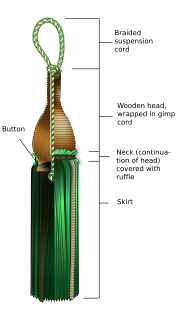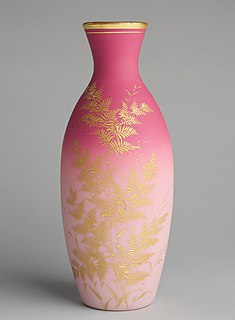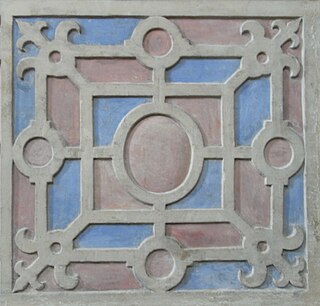Related Research Articles

Ink is a gel, sol, or solution that contains at least one colourant, such as a dye or pigment, and is used to color a surface to produce an image, text, or design. Ink is used for drawing or writing with a pen, brush, reed pen, or quill. Thicker inks, in paste form, are used extensively in letterpress and lithographic printing.

The arabesque is a form of artistic decoration consisting of "surface decorations based on rhythmic linear patterns of scrolling and interlacing foliage, tendrils" or plain lines, often combined with other elements. Another definition is "Foliate ornament, used in the Islamic world, typically using leaves, derived from stylised half-palmettes, which were combined with spiralling stems". It usually consists of a single design which can be 'tiled' or seamlessly repeated as many times as desired. Within the very wide range of Eurasian decorative art that includes motifs matching this basic definition, the term "arabesque" is used consistently as a technical term by art historians to describe only elements of the decoration found in two phases: Islamic art from about the 9th century onwards, and European decorative art from the Renaissance onwards. Interlace and scroll decoration are terms used for most other types of similar patterns.

Shellac is a resin secreted by the female lac bug on trees in the forests of India and Thailand. It is processed and sold as dry flakes and dissolved in alcohol to make liquid shellac, which is used as a brush-on colorant, food glaze and wood finish. Shellac functions as a tough natural primer, sanding sealant, tannin-blocker, odour-blocker, stain, and high-gloss varnish. Shellac was once used in electrical applications as it possesses good insulation qualities and it seals out moisture. Phonograph and 78 rpm gramophone records were made of it until they were replaced by vinyl long-playing records from the 1950s onwards.

Celtic knots are a variety of knots and stylized graphical representations of knots used for decoration, used extensively in the Celtic style of Insular art. These knots are most known for their adaptation for use in the ornamentation of Christian monuments and manuscripts, such as the 8th-century St. Teilo Gospels, the Book of Kells and the Lindisfarne Gospels. Most are endless knots, and many are varieties of basket weave knots.
Composition or Compositions may refer to:

In printing, type metal refers to the metal alloys used in traditional typefounding and hot metal typesetting. Historically, type metal was an alloy of lead, tin and antimony in different proportions depending on the application, be it individual character mechanical casting for hand setting, mechanical line casting or individual character mechanical typesetting and stereo plate casting. The proportions used are in the range: lead 50‒86%, antimony 11‒30% and tin 3‒20%. Antimony and tin are added to lead for durability while reducing the difference between the coefficients of expansion of the matrix and the alloy. Apart from durability, the general requirements for type-metal are that it should produce a true and sharp cast, and retain correct dimensions and form after cooling down. It should also be easy to cast, at reasonable low melting temperature, iron should not dissolve in the molten metal, and mould and nozzles should stay clean and easy to maintain. Today, Monotype machines can utilize a wide range of different alloys. Mechanical linecasting equipment uses alloys that are close to eutectic.

A tassel is a finishing feature in fabric and clothing decoration. It is a universal ornament that is seen in varying versions in many cultures around the globe.

Art glass is a subset of glass art, this latter covering the whole range of art made from glass. Art glass normally refers only to pieces made since the mid-19th century, and typically to those purely made as sculpture or decorative art, with no main utilitarian function, such as serving as a drinking vessel, though of course stained glass keeps the weather out, and bowls may still be useful.

Idli or idly are a type of savoury rice cake, originating from the Indian subcontinent, popular as breakfast foods in Southern India and in Sri Lanka. The cakes are made by steaming a batter consisting of fermented black lentils (de-husked) and rice. The fermentation process breaks down the starches so that they are more readily metabolised by the body.

Whitewash, or calcimine, kalsomine, calsomine, or lime paint is a type of paint made from slaked lime (calcium hydroxide, Ca(OH)2) or chalk calcium carbonate, (CaCO3), sometimes known as "whiting". Various other additives are sometimes used.

Papier-mâché is a composite material consisting of paper pieces or pulp, sometimes reinforced with textiles, bound with an adhesive, such as glue, starch, or wallpaper paste.

Moulding, also known as coving(United Kingdom, Australia), is a strip of material with various profiles used to cover transitions between surfaces or for decoration. It is traditionally made from solid milled wood or plaster, but may be of plastic or reformed wood. In classical architecture and sculpture, the molding is often carved in marble or other stones.

In architecture and decorative art, ornament is a decoration used to embellish parts of a building or object. Large figurative elements such as monumental sculpture and their equivalents in decorative art are excluded from the term; most ornaments do not include human figures, and if present they are small compared to the overall scale. Architectural ornament can be carved from stone, wood or precious metals, formed with plaster or clay, or painted or impressed onto a surface as applied ornament; in other applied arts the main material of the object, or a different one such as paint or vitreous enamel may be used.

In the history of art and design, strapwork is the use of stylised representations in ornament of ribbon-like forms. These may loosely imitate leather straps, parchment or metal cut into elaborate shapes, with piercings, and often interwoven in a geometric pattern. In early examples there may or may not be three-dimensionality, either actual in curling relief ends of the elements, or just represented in two dimensions. As the style continued, these curling elements became more prominent, often turning into scrollwork, where the ends curl into spirals or scrolls. By the Baroque scrollwork was a common element in ornament, often partly submerged by other rich ornament.

Animal glue is an adhesive that is created by prolonged boiling of animal connective tissue. In addition to being used as an adhesive it is used for coating and sizing, in decorative composition ornaments, and as a clarifying agent.

Investment casting is an industrial process based on lost-wax casting, one of the oldest known metal-forming techniques. The term "lost-wax casting" can also refer to modern investment casting processes.

Cabinet pudding, also known as chancellor's pudding or Newcastle pudding, is a traditional English steamed, sweet, moulded pudding made from some combination of bread or sponge cake or similar ingredients in custard, cooked in a mould faced with decorative fruit pieces such as cherries or raisins, served with some form of sweet sauce. Other versions of cabinet pudding might use gelatin and whipped cream.
Pick Szeged is a Hungarian company that produces a variety of meat products, most notably Winter salami. It was founded in 1869, and remains based in Szeged, Hungary.
Isabella Cortese, was an Italian alchemist and writer of the Renaissance. All that is known of her life and work is from her book on alchemy, The Secrets of Lady Isabella Cortese. Cortese was also well-versed in several fields other than alchemy. She helped develop a variety of facial cosmetic products and made a variety of other contributions to science during the 16th century.
George Jackson (1766–1840) was a British plasterwork innovator, active from 1780 onwards. He was commissioned by architect Robert Adam to produce reverse-cut boxwood moulds. Jackson formed a company which still produces composition pressings and retains a boxwood mould collection.
References
- ↑ Loeffler (1992). Step-By-Step Compo and Mold Making. Loeffler-Valac Industries. ISBN 0-9632387-5-2.
- ↑ Curson, Paul. Framing & Gilding. Australia: Skills Publishing Pty Ltd. ISBN 0-646-12673-3.
- ↑ https://www.nps.gov/tps/how-to-preserve/briefs/34-composition-ornament.htm
- ↑ "Composition". George Jackson.